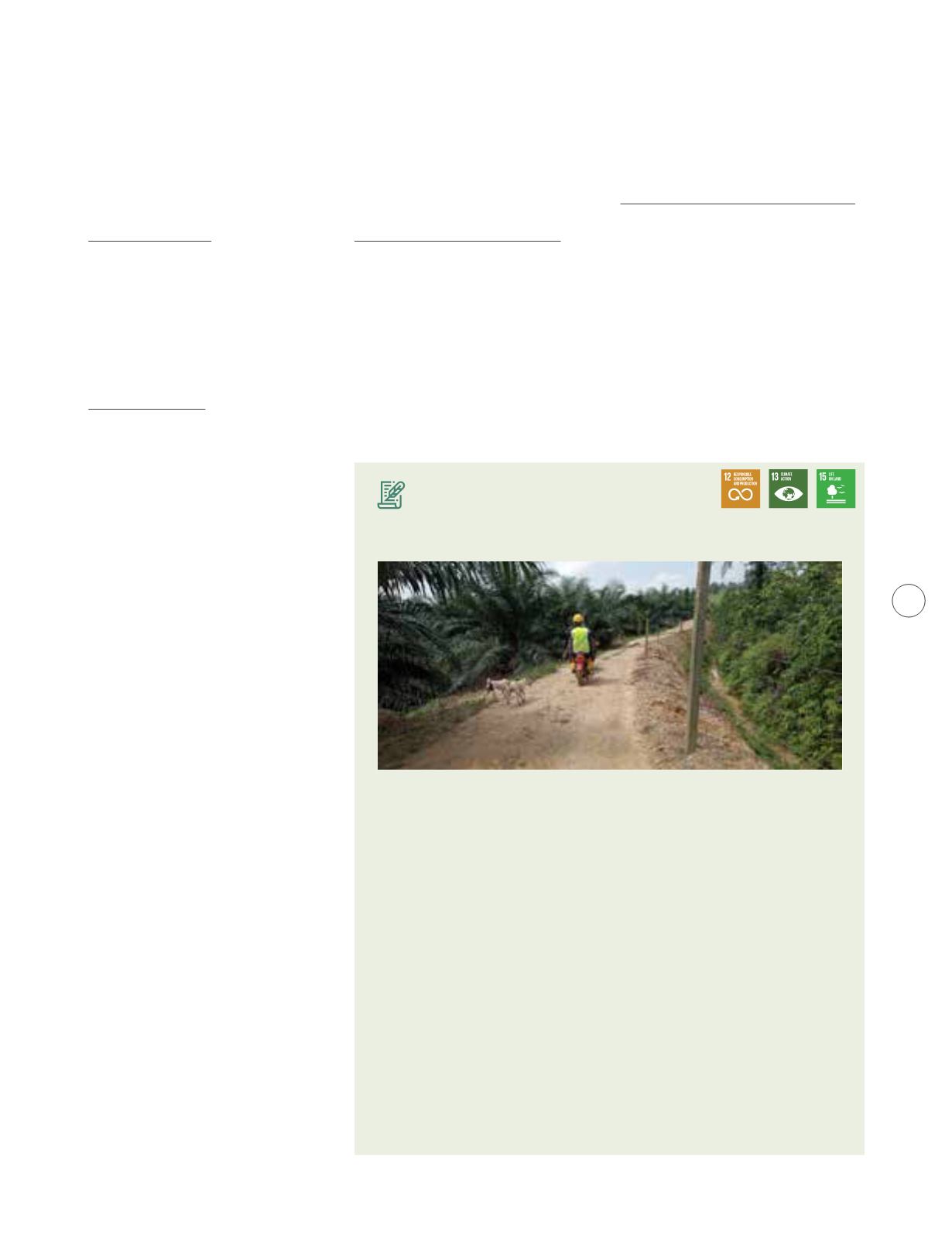

To live up to this, our key priorities
include:
Sustainable Agricultural Practices
Conservation areas
Within our estates, areas alongside
river banks (riparian reserves) are set
aside as conservation areas wildlife
corridors which include, among others,
sanctuaries for migratory birds and
habitat for jungle flora and fauna.
Soil Management.
We adopt best agricultural practices,
planting cover crops such as Mucuna
bracteata, Calopogonium mucunoides
and Calopogonium coeruleum, alone
or in combination, to boost surface
properties and minimise carbon
dioxide emissions. Vetiver grass is a
deep-rooted grass noted for its strong
resistance of heavy metals, phosphates,
nitrates and agricultural chemicals.
It has been cultivated in wetlands,
bundles and field drain to reduce
deforestation and avoid landslides.
Also, no planting is carried out in steep
regions, i.e. those with a slope of more
than 20 degrees. Another method in soil
management and slope is the planting
of Mucuna bracteata, which is an
Indian leguminous plant. We are highly
successful in reducing soil erosion and
improving soil quality by natural soil
fertilisation and aeration process. The
nitrogen-regulating properties help
maintain soil temperatures down during
hot seasons. We value its fast-growing
characteristics that allow rapid ground
cover and help suppress weed growth.
Lastly, our estate has carried into
practice sustainable land applications
that are aligned with our zero-waste
approach. The FFB which has been
harvested and sent to the mill for
processing will end up as Empty Fruit
Bunch (“EFB”) that is used by applying
directly to the field. In addition,
compost can be produced from a
mixture of shredded EFB and Palm
Oil Mill Effluent (“POME”) which is
subsequently added to the plot. Such
activities help to provide an ecological
supply of nutrients and reduce our
reliance on inorganic substances.
Biological controls against pests
Beneficial plants such as Turnera
Subulata, Antigonan Leptopus and
Cassia Cobanensis are cultivated
to lure leaf insect predators. These
predators feed on leaf pest larvae, thus
reducing the usage of pesticides. The
use of barn owls in our estates helps to
control the population of rodents, and
the placement of pheromone traps to
catch Rhinoceros beetles is one of the
Sustainability : Environment
strategies implemented and has proven
to be effective.
Managing Human-Elephant Conflicts
Several of our estates have encountered
incidences of elephant encroachment
into their areas culminating in crops
and property damage. In this regard,
we are continuously looking at ways to
find solutions which include monitoring
elephant movements, restoring wildlife
corridor and building up trenches to
minimise further incidences of crop-
raiding and damage to the extent
possible while at the same time
preserving the elephants’ natural habitat.
During the year, Cendana Laksana
Sdn Bhd together with 8 other
estates from 3 nearby localities,
had facilitated the establishment
of an Elephant Conflict Task Force.
The main objective of the Task
Force is to find workable solutions
to mitigate the economic impact
of crop loss to elephants whilst
maintaining the biodiversity of the
ecosystems they inhabit. These
include, inter alia, understanding
the local ecology, monitoring and
recording the movement pattern
of elephants in the affected
areas and co-ordination of other
activities by and amongst the task
force members.
Addressing the elephant in the room
“Managing the human-elephant
conflict is as much about
protecting our estates from crop-
raiding elephants as it is about
reducing our footprint on the
elephant’s habitats and corridors.
We have these taken into account
through inter alia, our land use
planning, improving their habitats
to increase their natural feed
availability (by planting crops that
elephants like e.g. bananas) which
in turn can keep them away from
encroaching on human areas. I
believe that these measures can
allow both to peacefully co-exist.”
Mohd Rashidi Mohd Yazid
Estate Manager, Ladang Cendana
Spotlight Story
kumpulan Fima Berhad
(197201000167)(11817-V)
Annual Report 2020
61












